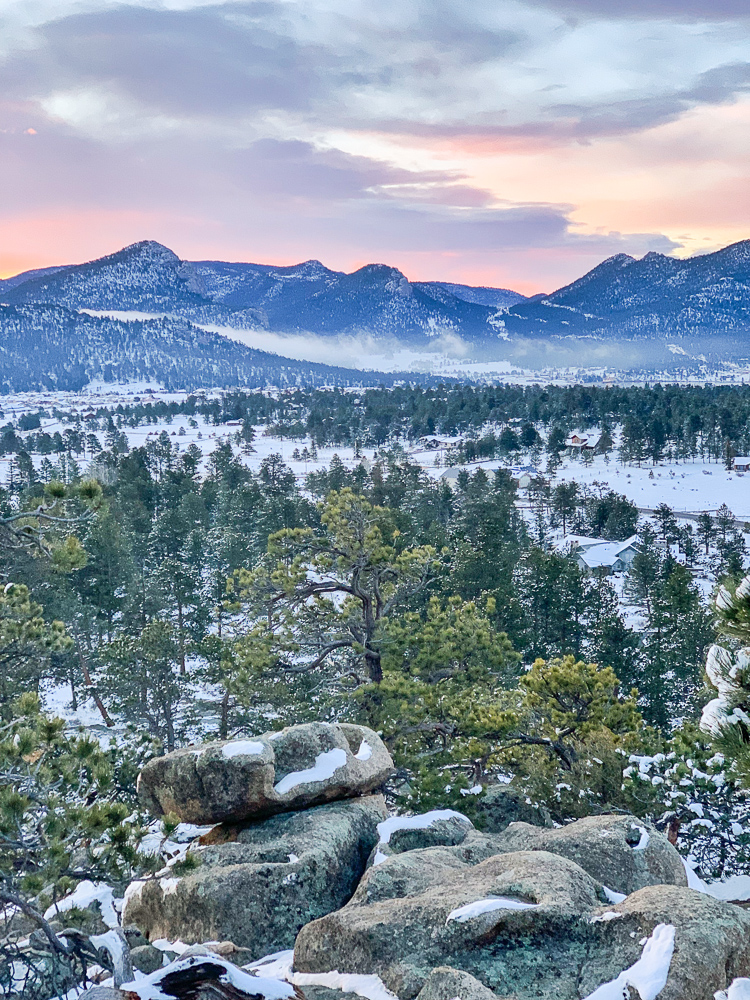Winter Trail Running in Estes Park and Rocky Mountain National Park
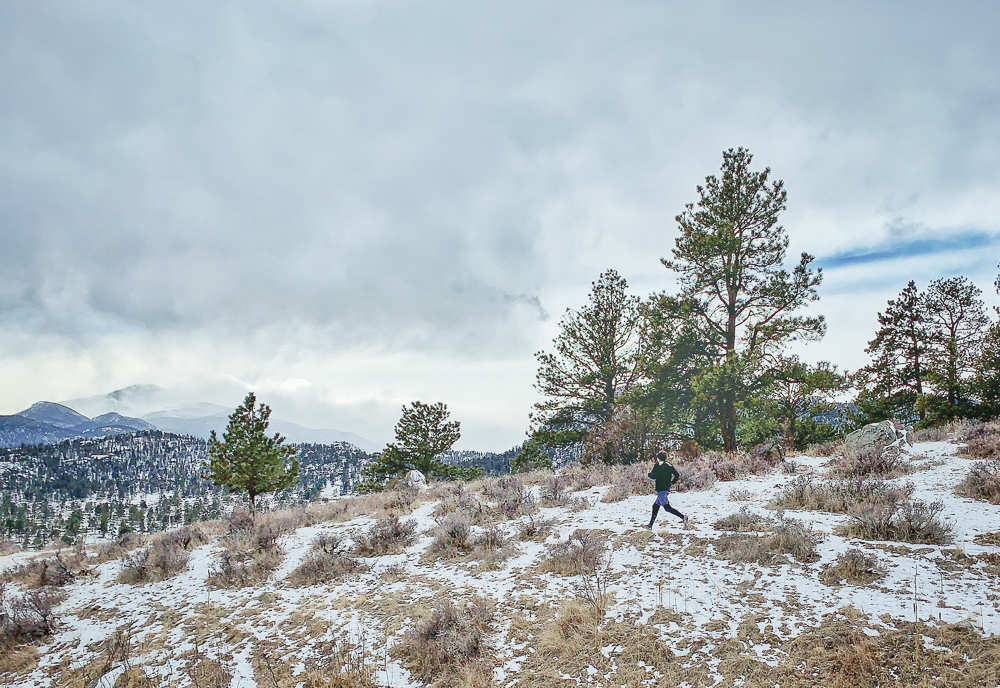
Trail Running is becoming increasingly popular all over the country, but even more so where the landscape offers miles of trails through stunning terrain. Estes Park and Rocky Mountain National Park absolutely fit that bill so, as one could expect, the trails are seeing an increasing number of runners around here.
Summer Trail Running is one thing, but how do you keep hitting the trail during the winter. With more gear options, winter trail running in Estes Park shouldn’t be intimidating. Obviously the weather and terrain pose more challenges and a bit more planning needs to go into it in order to keep logging those miles safely. Here, I’ll outline how we get it done all winter long, no matter the temps, no matter the weather, and no matter the trail… After all, there is no bad weather, just bad gear.
ON YOUR FEET
The first thing people usually ask is what we wear on our feet throughout the winter running season (which can be 8 months long up here in the high country). So, let’s break it down:
Socks: I prefer Smartwool, DryMax, or Darn Tough socks no matter the season. Even their thin, summer, socks keep my feet warm enough except on the coldest of days. But they all have a wide variety to suit your preference.
Shoes: This is always a tricky one. My only real advice is to use what you normally would use for trail running as everyone has his or her preferred shoe of choice. I prefer the Altra Lonepeak for winter running. Altra also makes a waterproof version of this shoe as well. Some other popular choices are Hoka, Topo, and Inov8, when hitting the winter trails. It may take some time and experimentation, but try a few different options and find what works best on your feet.
Traction: Even the most aggressive trail shoes won’t mean a thing on bulletproof ice. With some warm days thrown in the mix during our winters we can get a mean freeze/thaw cycle, especially at lower elevations in RMNP and around town. This can cause some super slick glare ice on trails like Gem Lake and Homer Rouse. You’ll definitely need something more substantial than big rubber lugs. I’ve tried them all and would strongly recommend Kahtoola Micro Spikes. These slip over any shoe, are easy to take on and off, last forever, and make it so you can run aggressively on any kind of ice. These changed my winter trail running life once I started using them, plain and simple.
ON YOUR LEGS
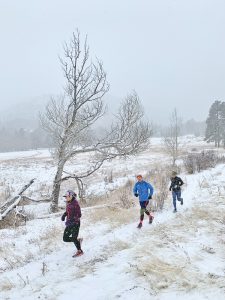 What you put on your legs will depend on your location and the temps. If I’m running near town, with friends, or on one of my normal trails, and the temps are above 10-15 degrees, I’ll still wear shorts as long as it’s not crazy windy. If it’s the same type of location but near or below 0, I’ll wear tights or some running pants. Depending on the wind, I may throw thermals on underneath. And I will usually wear pants and thermals if I’m going deeper into the park like into Wild Basin or Glacier Gorge. Again, play with different variations on your legs erring on the side of being too warm until you get some experience with different conditions, distances, and destinations.
What you put on your legs will depend on your location and the temps. If I’m running near town, with friends, or on one of my normal trails, and the temps are above 10-15 degrees, I’ll still wear shorts as long as it’s not crazy windy. If it’s the same type of location but near or below 0, I’ll wear tights or some running pants. Depending on the wind, I may throw thermals on underneath. And I will usually wear pants and thermals if I’m going deeper into the park like into Wild Basin or Glacier Gorge. Again, play with different variations on your legs erring on the side of being too warm until you get some experience with different conditions, distances, and destinations.
ON TOP
Layers, layers, layers. My preferred set up on my upper body is a long sleeve tech tee under a short sleeved tech tee. And, honestly, this is all I usually need. If the wind is really ripping, or it is pretty cold, I’ll throw a performance fleece and/or a wind layer on top as well. In the most extreme conditions I’ll even throw a down hooded coat over it all. On most runs, I’m too hot, so this system works pretty well as I can easily manage my body’s temps by adding or removing layers as needed. I will say to be careful about getting too hot during the winter as if you had to stop or slow down (due to injury or fatigue) clothes wet with sweat can cause you to get hypothermic very quickly. So do stop to shed layers if you’re starting to sweat too much. Overall, just keep it simple and dress in layers.
COVER YOUR DOME
What you put on your head is pretty straightforward. A beanie if it’s cold, and a regular cap if it’s not too bad. A lot of folks will use a Buff (half buff) and use it like a headband to cover their ears. This works very well. If I am using a beanie and it gets too warm, I just flip the bottom up a bit until my ears are exposed and it cools me off pretty quick.
HANDS
Obviously, wear some gloves, or at least bring them along. Unless it’s close to 0, I can get away with a running glove mitt combo. The mitten tucks into the wrist band of the glove. I tuck it away when not needed and flip it over my hand if the wind picks up or if it’s super cold. If it does dip to near or below zero, I will use a small ski mitten. Even in the coldest conditions, I don’t need much on my hands once I get the blood pumping. With that said, if I’m running longer and carrying a pack, or going deeper into the mountain (with a pack) I always carry an extra pair of gloves. I’ve had sweaty gloves freeze almost solid during a winter run to Timberline Falls in -20 temps. I took them off for about 30 seconds to snap a picture and when I tried to get them back on they were ice cubes. A very uncomfortable and, frankly, a scary run back to my car. And I’ve also had a glove fall out of a pocket. So just throw an extra pair in to be safe. In addition, I have a pair of hand warmers in my pack during the winter. I’ve only had to use them once (when the glove fell out of my pocket), but it saved me.
EYES
Wear sunglasses! Running on snow is bright. Protect those eyes! Here are a few I would recommend: Goodr; Julbo; etc…
FUEL
This is very similar to what you would do during the summer with a few things to note. As a rule, just use what you’re used to. Bars, gels, gummies, etc… Just know that bars and chews can get pretty hard and can be difficult to eat on the run. I tend to lean more toward gels. I’ve used VFuel in temps below -20 and it’s still liquid and easy to ingest, aside from the fact that it’s some of the best endurance fuel in existence. Depending on the length of your run, your exertion, etc, just adjust your caloric intake accordingly.
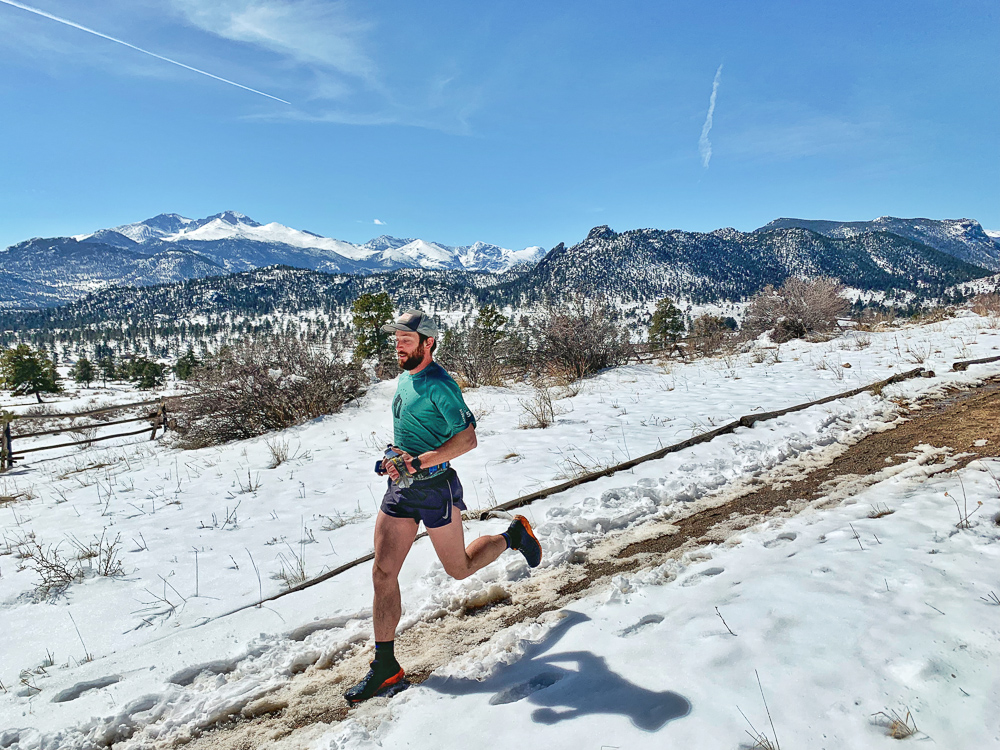
HYDRATION
This can be tricky depending on what you are used to using. I find handheld bottles work the best. Ultimate Direction sells wonderful products. I would avoid using a bladder in your pack as the water in the tube freezes very easily in cold conditions. With a bottle, it may freeze in the nipple, but a little chew or bite on it will free it up 99% of the time. If you usually filter your water during your runs (from a stream or lake), know that most water sources are frozen over so you may need to carry more than you would on a longer summer outing. Drink when you’re thirsty! Don’t over think it.
PACK
Last, but certainly not least, your pack plays an important role during the winter. You need more gear in the winter months and with our high country sun’s intensity, you can often find yourself needing to shed a layer or two even on chilly days. And nothing is worse than having to hold the extra gear or tie it to your person somehow.
Ultimate Direction makes my pack of choice. I have an older Bakwin Adventure Pack (Mens & Womens) in their signature series. These are truly amazing pieces of wearable gear. They are basically bomb proof, which is why I have an old one. It still works as well as it did when it was brand new, four years, and about 5,000 miles ago. And their newer ones are even better. I like their packs because there is plenty of storage space but it cinches down and doesn’t bounce around. And the water bottles are stored in the front for super easy access, as well as front and side pockets for storing things like fuel, filter, headlamps, cell phone, whatever.
Here is a list of the ‘extras’ I keep in my pack in the winter.
- Extra Gloves
- Baggie with a space blanket, starter sticks/matches
- MicroSpikes
- Toilet Paper/Trowel
- Headlamp (always carry just in case)
- Water Filter (SteriPen Adventure Opti)
- Drywall Saw (can use for endless reasons during an emergency)
- ER Shears (can also be used for a number of reasons)
- Handwarmers
- Ibuprofen
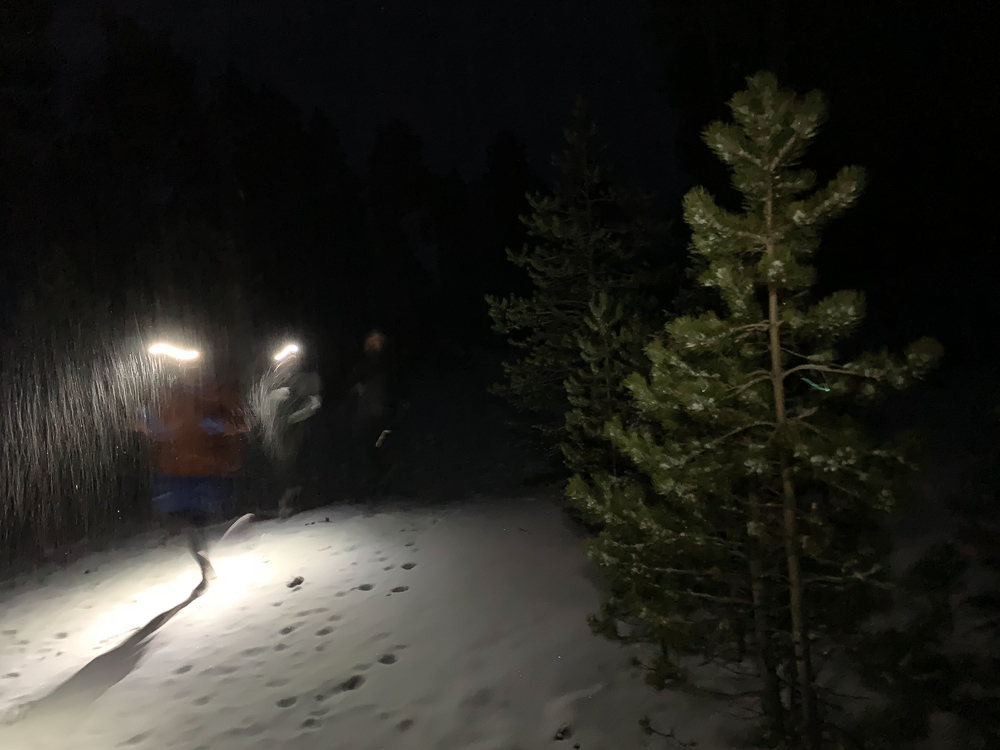
EXTRAS
I always keep a headlamp in my pack, especially in the winter, for obvious reasons. I also make sure that the batteries are relatively fresh.
Another couple of items I keep in the pack year round are a drywall saw and ER Shears. If you needed to make a splint, or a stretcher, you can easily cut through descent-sized branches. You can also cut through hard packed snow or ice to get to water if needed. The ER shears make it easy to cut through fabric for splints or wraps, etc. This may seem like overkill. If it does seem that way to you, I would strongly recommend taking a Back Country First Responder Course and get certified. Here in Estes, you can take the course through the Estes Park Mountain Shop. It’s a wonderful course and really opens your eyes to how even being slightly prepared, like carrying these two items, which weigh nothing, can make a world of difference. While I have never had to use these in an emergency, if I trail run in the back country long enough, the day will come when these will come in handy.
While this all may seem like a ton of information, winter trail running is actually pretty straightforward. It just takes a little more planning and a little more gear. Be sure to know what the weather is doing and if you’re going into avalanche terrain, know the current conditions. Most places where trail running will take you will be pretty safe as far as avalanche danger is concerned, but it’s something to simply be aware of and take the necessary precautions. The bottom line is to simply lace up and have fun.
One final thing to note is to be aware of how you enjoy these wild places. Be extra mindful of the trash you may produce. With these winter winds it’s that much easier for a bar wrapper or a gel packet to whisk away. With gloves on, it’s harder to stow trash in your pockets or your pack. Be aware of what you’re packing in and be doubly sure not to leave anything behind. It’s always good to periodically review the Leave No Trace Principles and not only apply them, but be a good example for other users of our precious wilderness.
Happy Trails!
Be sure to check out the links in the article above and feel free to call or email us with any other questions. If you want to know trail conditions, the best runs for any given ability or desired terrain/length, etc, or just for some more beta on winter running in general, please, please, please, let us know! Trail and ultra running are one of the owners, Michael’s, passions and he’d love to chat about any and all of it.
If you want to see his latest ultra race report, and learn about why he’s having to take a couple of months off his feet, check out the following link: http://michael-hodges.com/blog/bandera-100k-version-2-0/
